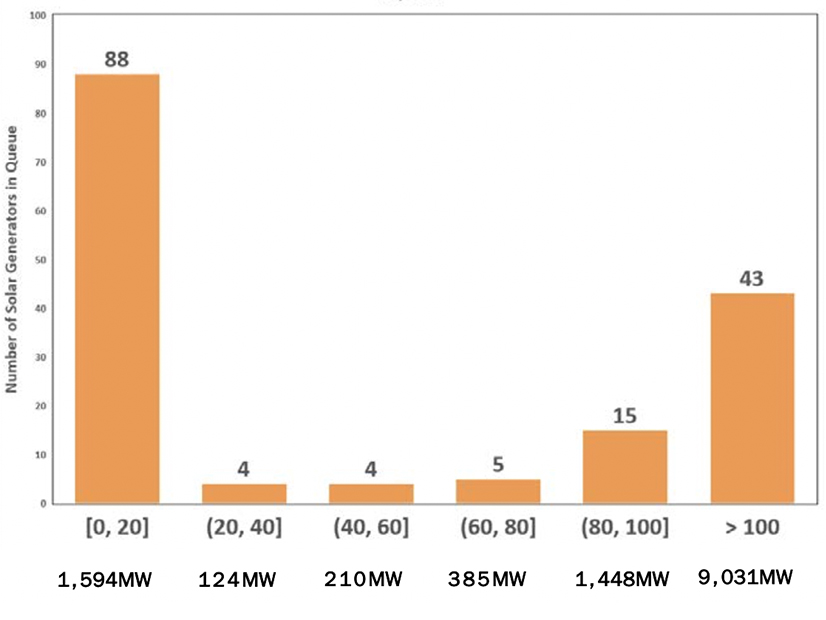Weather Data Exemption for Small Solar
The NYISO Business Issues Committee on Tuesday recommended that the ISO’s Management Committee approve tariff revisions to exempt solar generators no larger than 20 MW from certain meteorological data collection and reporting requirements.
Consistent with FERC Order 764, the ISO’s Services Tariff Section 5.8 requires solar resources to collect and maintain certain meteorological data required for energy forecasting, but Order 764 was targeted at large generators, identified as those greater than 20 MW. The order requires solar resources to provide, at a minimum, site-specific meteorological data, including temperature, atmospheric pressure and irradiance.
If approved by the Management Committee and the ISO’s Board of Directors, NYISO will make a Section 205 tariff filing with FERC.
The ISO’s forecast vendor has data necessary to forecast solar energy production for small solar resources consistent with the characteristics and location, and uses a combination of satellite data, weather data and data from NYS Mesonet, a network of 126 weather stations with at least one in all 62 counties in the state.
AS, Reserves and CSR-related Manual Updates
The BIC also approved minor changes to three manuals to reflect changes for both the ancillary services shortage pricing and reserves for resource flexibility projects.
Based on stakeholder feedback, incremental changes were made to the proposed revisions for Section 4.3.4 of the Day-Ahead Scheduling Manual, Section 7.3.6 of the Transmission and Dispatch Operations Manual and sections 6.8.1 and 6.8.2 of the Ancillary Services Manual.
Changes to both the Day-Ahead Scheduling Manual and the Transmission and Dispatch Operations Manual updated the operating reserve demand curve values and clarified the descriptions of the various demand curves.
The BIC also approved revisions to the same three manuals to address implementation of the co-located storage resources (CSR) participation model.
The changes added language to include additional factors, such as scheduling limits, considered by security constrained unit commitment (SCUC) for CSR generators.
FERC in March accepted NYISO rules allowing an energy storage resource to participate in the wholesale markets with wind or solar as a CSR. The ISO currently anticipates that the CSR-related tariff revisions will become effective in the fourth quarter, following testing of needed software changes. (See FERC Approves NYISO Co-located Storage Model.)
Uneconomic Production and Uneconomic Withdrawal
The Business Issues Committee approved, with one vote against and one abstention, changes to the rules governing uneconomic production and uneconomic withdrawal to ensure that mitigation measures appropriately address such situations.
Previous limitations to the rules included: requiring intent on the part of a resource “to cause, and obtain benefits from” uneconomic production or withdrawal, challenges with the conduct test when references are low or negative, and challenges with the impact test being limited to an increase of 200% or $100/MWh.
The new definition of uneconomic production and uneconomic withdrawal uses language from the definition of physical withholding, removes intent from the definition, and is more consistent with economic withholding and physical withholding.
The current threshold for triggering an impact test for uneconomic production or uneconomic withdrawal is: (1) a change of 200% or $100/MWh, whichever is lower, in the hourly Day-Ahead LBMP, real-time LBMP, Day-Ahead congestion component, or real-time congestion component; or (2) an increase of 200%, or 50% for generators in a constrained area, in bid production cost guarantee payments or day-ahead margin assurance payments to a market participant or affiliate.
For purposes of the first trigger, a change is defined as the absolute value of the difference between the prices or congestion components that resulted from the market participant’s uneconomic production or uneconomic withdrawal behavior and those that would have occurred if the market participant had operated in a competitive manner consistent with its reference levels. The new definition requires a minimum change in price of $25/MWh.
The proposed revisions are intended to help ensure the impact test does not generate very tight thresholds when LBMPs or congestion is low.
The Market Administration and Control Area Services Tariff section 23.4.3.3.2 clarifies that the mitigation measure is a penalty calculated as 1) 1.5 times the increase in guarantee payment(s) to the conduct-failing generator for uneconomic production, and 2) 1.5 times the absolute value of the congestion component of the LBMP, times the quantity of megawatts produced by the conduct-failing generator for uneconomic withdrawal.
The tariff provides opportunity for consultation between NYISO and a market participant prior to applying mitigation, and the ISO will consider participant demonstrations that the questioned conduct was consistent with competitive behavior.
Economic Planning Manual Update
The BIC also approved updates to the Economic Planning Process Manual to reflect the enhancements to the Economic Planning Process that were implemented through the revised NYISO tariff approved by FERC earlier this year. The changes include a process description of the System and Resource Outlook as well as the defined terms for related studies.
The changes update the description and defined terms for the Economic Transmission Project Evaluation (ETPE), formerly, CARIS Phase 2, and for the Requested Economic Planning Study (REPS), formerly the Additional CARIS Study.
FERC in April accepted tariff revisions to the ISO’s economic planning process, effective April 11 (ER21-1074).
“We no longer use the term CARIS, for Congestion Assessment and Resource Integration Study, using instead the System and Resource Outlook to encompass its wider scope,” said Jason Frasier, NYISO manager of economic planning.
The ISO will begin the 2021-2040 System and Resource Outlook kickoff at the Sept. 22 Electric System Planning Working Group (ESPWG), where staff will present the study plan and reference case assumptions, with preliminary results to be presented at the ESPWG in late October or early November.

